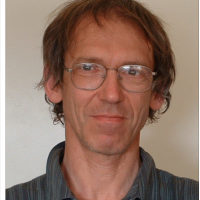Eric Lantz worked from 1979 to 1985 in industry in the field of solar energy and heat pumps. In 1986, he joined the Optics Laboratory of Besançon, now included in FEMTO ST, and received in 1989 the Ph. D. degree from the Université de Franche Comté, where he is currently professor.
His Ph. D. was devoted to super-resolution in microscopy by inverse problem methods. Since 1989, he has worked in the non linear optics group of the laboratory, where he initiated studies about travelling-wave parametric image amplification in crystals. He proposed using its time-gating properties to perform imaging in diffusing media, with results published in the 1990's. More recently, he engaged a research activity about imaging in diffusing media by phase conjugation, with the support of the ANR (contract ICLM, 2011-2014). The almost instantaneous character of phase conjugation by parametric amplification alloweda significant improvement of the signal to noise ratio for scattering media in motion, like an in vivo biological medium (Devaux JBO 2013).
Since 2000, he has been involved in quantum optics, by studying spatial fluctuations in parametric images, first in the frame of the European contract "Quantum imaging" (2001-2004), then with the support of the ANR contract "Information and quantum communication" (2005-2008), and, recently, of the LABEX Action, as local PI in all these contracts. Main results include:
- image noiseless amplification (one of the Quantim principal results, Mosset PRL 2015),
- demonstration of the highest degree ever reported of Einstein-Podolsky-Rosen paradox, by correlating images at the single photon level (Moreau PRL 2014),
- demonstration of EPR paradox on single couples of images, showing that an image is by itself a quantum object, without any need of ensemble or time averaging (Lantz OE 2015)
- work on temporal ghost imaging, both classical and quantum (Devaux Optica 2017).

